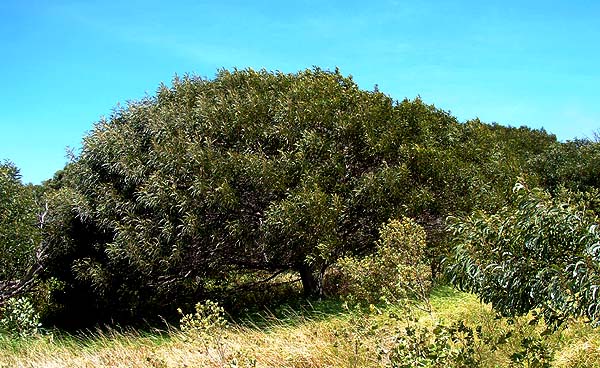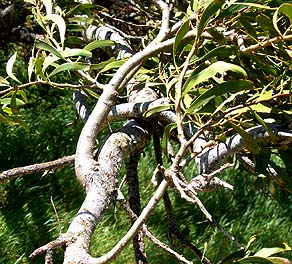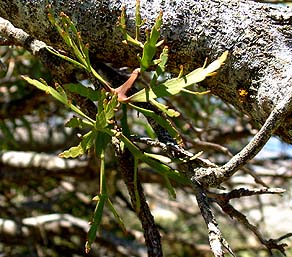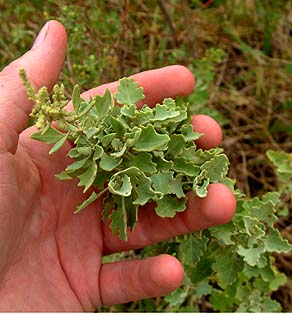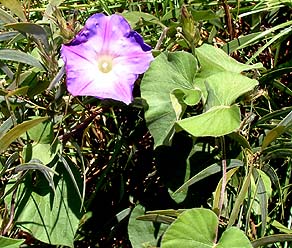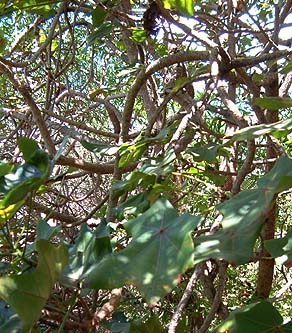|
Species of the Pu‘u Loa Koai‘a Reserve:
Koai‘a, also called koai‘e.
|
"The koai‘a is one of those amazing trees," Sam explains. "It’s a very slow growing hard-wooded tree and yet, because it’s related to koa, when the conditions are right it can grow really fast. So it can get started and it can grow and it can replace itself fairly readily, which is one of the reasons why it’s one of the last tree forms that you can find. Even in the cattle pastures. The koai‘a’s wood is strong and hard and fine-grained, and really wonderful for tools and the like. Because it’s so gnarled, it wasn’t used all that much for long weapons such as spears, but it would have been great for clubs and for smaller implements and weapons."
|
||
|
|
||
"It has two alternate names, koai‘a and koai‘e, that you find in different parts of the Hawaiian Islands these trees grow. It’s the same plant, just different names. 'Koai‘a' has been explained to me as related to the wood of this tree being used to make the large wooden hooks for shark fishing. I‘a is fish, and so koa-i‘a would be ‘koa for fish.’ That’s one of the uses for koai‘a. "And i‘e is the kapa pounder, and so the hard wood of koai‘e would be just fine for that kind of use. So ‘koa for the i‘e’—koai‘e—is the alternate name for koai‘a. And sometimes you hear people pronouncing it 'koa-i‘a' or 'koa-i‘e,' but that’s just wrong."
|
|
|
“The hulumoa is a native mistletoe that grows on a wide variety of things. There’s some evidence that different species grow on different hosts, and certainly the one that grows on koai‘a is quite distinctive looking. I wouldn’t be surprised if it’s own species." Hulumoa literally means "chicken feathers," and the plant is so named because of its resemblance to the tail of a rooster. The plant is also called kaumahana. "In the koai‘a reserve are all kinds of things growing," Sam continues, "but the main things that were not planted there include ‘ilima and naio and ‘aweoweo."
|
|
|
|
"The ‘aweoweo is a very common shrub. You can find it growing from the coast all the way up to some alpine elevations. In fact, there’s an ‘aweoweo shrubland up in the Pohakuloa training area—one of the only places where you can find a sub-alpine shrub land of ‘aweoweo. "You hear the name ‘aweoweo in different chants, so you know it’s of cultural significance. We hear of it as a symbol of Pele, and that’s not surprising for a plant that often has red stems and grows in lava cinder lands. "But ‘aweoweo is also the name of a fish and it’s really amazing how fishy that thing smells when you grab the young leaves and crush them in your hand. It was used in a lot of la‘au lapa‘au [traditional medicine] recipes, and you can also steam the young foliage as a vegetable dish."
|
|
Koali.
|
"Koali is a morning glory. A lot of the morning glories that you see, even in cattle pastures, are native ones. They’re also very hardy. When the winter rains come, the seeds in the ground start to grow and they also have underground tubers that can go through the drought. "Koali is also mentioned often in the la‘au lapa‘au recipes, Hawaiian herbal remedies. And you hear names like koali awa, koali pehu—different species of koali that might be used for different kinds of ailments."
|
“There is a hau kuahiwi [mountain hibiscus], the kokia, and that particular relative of hibiscus is a really fantastic-looking plant. Gnarled and with maple-shaped leaves. The bark provides a bright red dye that was used to stain the nets of ‘olona red, since red is a color that invertebrates and small fish have a hard time seeing. Instead of being bright red to their eyes, it’s essentially black or dark. "It’s really neat that Hawaiians of old recognized that, even though to their eyes it seems quite bright. It was the most effective color for fishing for small animals in the tide pools. It used to be quite a common plant, and so it had that use by fishermen." “But when cattle were introduced and they started ravaging the countryside and stripping the bark off of native trees, that tree became very rare and is extirpated through most of it’s range."
|
|
|
|
|
"You don’t use the word ‘extinct’ until the last one is gone, so we say it was 'extirpated' through most of its range. This one was planted here decades ago, as this was one of the protected sites in which they thought it would do well. Actually, it grows throughout the Kona area and is famous for growing in Pu‘u Wa‘awa‘a area. However, this protected place at Pu‘u Loa Koai‘a Sanctuary has been really good for that particular plant.”
|
||
|
|
||
|
|||||
|
|||||
